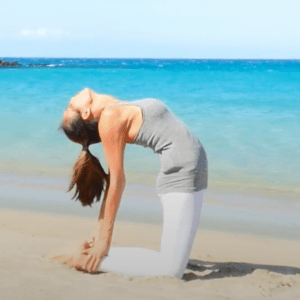Two poses for today are Sphinx Pose and Supported Shoulder Stand
Sphinx Pose and Supported Shoulder Stand
Supported Shoulder Stand
Steps
- Shoulderstand is entered from a supine position with the knees bent. The shoulders may be supported on folded blankets, and the upper arms may be held in with a belt just above the elbows.
- Beginners may lift with bent legs, advanced users with straight legs. The back is supported by the hands: once up, the hands reach lower down the trunk towards the head, and the trunk is lifted further; the legs may then be straightened to a vertical position.
Benefits:
- Calms the brain and helps relieve stress and mild depression
- Stimulates the thyroid and prostate glands and abdominal organs
- Stretches the shoulders and neck
- Tones the legs and buttocks
- Improves digestion
- Reduces fatigue and alleviates insomnia
Sphinx Pose
Sphinx Pose is a gentle back bending posture that can be practiced either actively or passively.
Steps
- Lie on your stomach with your toes flat on the floor and forehead resting on the ground.
- Keep your legs close together with your feet and heels lightly touching.
- Stretch your hands in front of you with your palms facing downward and arms touching the ground. Set your elbows under your shoulders and forearms parallel to each other.
- On an inhale, slowly lift your head, chest,
and abdomen while keeping your navel on the floor. - Pull your torso back and off the floor with the support of your arms.
- Ensure that your feet are still close together and your head facing straight ahead.
- On an exhale, gently lower your abdomen, chest, and head onto the floor.
Benefits
- Strengthens the spine
- Stimulates the abdominal organs
- Expands the chest and shoulders
- Improves circulation
- Relieves stress
Sphinx Pose and Supported Shoulder Stand improve digestion and reduce fatigue, and alleviate insomnia.




